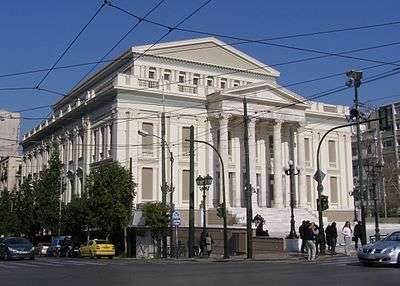Modern Greek architecture
After the Fall of Constantinople and the following trends of Greek migration to the diaspora, Greek architecture was concentrated mainly on the Greek Orthodox churches of Diaspora. These churches, such as other intellectual centres built by Greeks (foundations, schools, etc.), was used also as a meeting-place. The architectural style of these buildings was heavily influenced by the western European architecture.
After the Greek War of Independence and the creation of the modern Greek state, the modern Greek architecture tried to combine the traditional Greek architecture and Greek elements and motives with the western European movements and styles.
The 19th-century architecture of Athens and other cities of the Greek Kingdom is mostly influenced by the Neoclassical architecture, with architects like Theophil Hansen, Ernst Ziller and Stamatios Kleanthis.
History
The architecture of the modern Greek cities, especially the old centres ("old towns") is mostly influenced either by the Ottoman or the Venetian architecture, two forces that dominated the Greek space from the early modern period.
After the Greek Independence, the modern Greek architects tried to combine traditional Greek and Byzantine elements and motives with the western European movements and styles. Patras was the first city of the modern Greek state to develop a city plan. In January 1829, Stamatis Voulgaris, a Greek engineer of the French army, presented the plan of the new city to the Governor Kapodistrias, who approved it. Voulgaris applied the orthogonal rule in the urban complex of Patras.
Two special genres can be considered the Cycladic architecture, featuring white-colour houses, in the Cyclades and the Epirotic architecture in the region of Epirus.
After the establishment of the Greek Kingdom, the architecture of Athens and other cities was mostly influenced by the Neoclassical architecture. For Athens, the first King of Greece, Otto of Greece, commissioned the architects Stamatios Kleanthis and Eduard Schaubert to design a modern city plan fit for the capital of a state.
Neoclassical examples
 Korais public library of Chios (1885)
Korais public library of Chios (1885) Municipal theatre of Piraeus (1895)
Municipal theatre of Piraeus (1895) Old city hall of Mytilene (1900)
Old city hall of Mytilene (1900) National Bank of Greece of Thessaloniki (1928)
National Bank of Greece of Thessaloniki (1928)
In 1917 most of Thessaloniki's old center of the city was destroyed by the Great Thessaloniki Fire of 1917. Following the fire the government prohibited quick rebuilding, so it could implement the new redesign of the city according to the European-style urban plan prepared by a group of architects, including the Briton Thomas Mawson, and headed by French architect Ernest Hébrard.
In 1933 was signed the Athens Charter, a manifesto of the modernist movement which published later by Le Corbusier. Architects of this movement were among others: The Bauhaus-architect Ioannis Despotopoulos, Dimitris Pikionis, Patroklos Karantinos and Takis Zenetos.
After the World War II and the Greek civil war, the massive construction of condominiums in the major Greek city-centres, was a major contributory factor for the Greek economy and the post-war recovery. The first scycrapers were also constructed during the 1960s and 1970s, such as the OTE Tower and the Athens Tower Complex.
During the 1960s and 1970s, Xenia was a nationwide hotel construction program initiated by the Hellenic Tourism Organisation (Ελληνικός Οργανισμός Τουρισμού, EOT) to improve the country's tourism infrastructure. It constitutes one of the largest infrastructure projects in modern Greek history. The first manager of the project was the architect Charalambos Sfaellos (from 1950 to 1958) and from 1957 the buildings were designed by a team under Aris Konstantinidis.
Famous foreign architects who have also designed buildings in Greece during the 20th and 21st century, include Walter Gropius, Eero Saarinen and Mario Botta. Several new buildings were also constructed by Santiago Calatrava for the 2004 Athens Olympics, while Bernard Tschumi designed the New Acropolis Museum.
Gallery
- Tower houses of Mani peninsula
 Traditional style houses in Nafplion
Traditional style houses in Nafplion Rooftops of Plaka, the old Athenian neighborhood with the traditional style houses
Rooftops of Plaka, the old Athenian neighborhood with the traditional style houses Our Lady of Tinos (1830)
Our Lady of Tinos (1830)- Villa Illision, designed by Stamatios Kleanthis (1848)
- Ermoupolis city hall, designed by Ernst Ziller (1876-1891)
- Cycladic architecture in Amorgos
 Epirotic architecture, Zagori
Epirotic architecture, Zagori- Houses of Agios Nikolaos, Chalkidiki, typical Greek village
 Menetés village, Karpathos
Menetés village, Karpathos Colourful houses of Symi island
Colourful houses of Symi island- View of the old town of Kavala
 Saint Andrew of Patras in Neo-Byzantine style (1908-1974)
Saint Andrew of Patras in Neo-Byzantine style (1908-1974)- The building of the National Bank of Greece in Nafplion in Mycenaean Revival architecture style (1930s)

- Peace and Friendship Stadium (1985)
See also
- Modern architecture in Athens
- Ancient Greek architecture
- Mycenaean Revival architecture
- Athens Charter
- Neoclassical architecture
